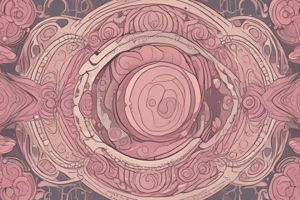Podcast
Questions and Answers
Which of the following is NOT a type of amenorrhea?
Which of the following is NOT a type of amenorrhea?
- Secondary amenorrhea
- Primary amenorrhea
- Amenorrhea during pregnancy
- Tertiary amenorrhea (correct)
What is the definition of menorrhagia?
What is the definition of menorrhagia?
- Pain around ovulation
- Absence of menstruation
- Intermenstrual bleeding
- Menstrual bleeding that is excessive in amount (correct)
Which of the following is NOT listed as a common cause of abnormal uterine bleeding?
Which of the following is NOT listed as a common cause of abnormal uterine bleeding?
- Lesions
- Stress (correct)
- Pregnancy complications
- Bleeding disorders
What is the term used to describe pain that many women experience around ovulation?
What is the term used to describe pain that many women experience around ovulation?
What is the primary step in the medical management of amenorrhea?
What is the primary step in the medical management of amenorrhea?
What is the treatment approach for abnormal uterine bleeding caused by breakthrough bleeding?
What is the treatment approach for abnormal uterine bleeding caused by breakthrough bleeding?
Which type of Dysmenorrhea is characterized by the presence of tissue resembling endometrium outside the uterus?
Which type of Dysmenorrhea is characterized by the presence of tissue resembling endometrium outside the uterus?
What is the primary cause of short-term, recurrent school absenteeism in adolescent girls?
What is the primary cause of short-term, recurrent school absenteeism in adolescent girls?
Which medication is commonly used to treat Dysmenorrhea by inhibiting prostaglandins?
Which medication is commonly used to treat Dysmenorrhea by inhibiting prostaglandins?
What is a common symptom of Premenstrual Syndrome (PMS) that involves feeling 'on edge' and irritability?
What is a common symptom of Premenstrual Syndrome (PMS) that involves feeling 'on edge' and irritability?
What is a typical characteristic of Primary Dysmenorrhea pain compared to Secondary Dysmenorrhea?
What is a typical characteristic of Primary Dysmenorrhea pain compared to Secondary Dysmenorrhea?
Which therapy is recommended for the reduction of Premenstrual Syndrome (PMS) symptoms like bloating and headaches?
Which therapy is recommended for the reduction of Premenstrual Syndrome (PMS) symptoms like bloating and headaches?
Study Notes
Menstrual Cycle Disorders
- Role of the nurse depends on the disorder's cause and treatment, involving teaching about medications and providing emotional support before and after procedures.
Amenorrhea
- Absence of menstruation, normal before menarche, during pregnancy, and after menopause.
- Primary amenorrhea: failure to menstruate by age 16 years, or failure to menstruate by age 14 years if she has not developed any secondary sex characteristics.
- Secondary amenorrhea: cessation of menstruation for at least three cycles or 6 months in a woman who previously had an established pattern of menstruation.
- Medical management: obtain thorough health history, physical examination, and labs, with treatments aimed at correcting the cause.
Abnormal Uterine Bleeding
- Uterine bleeding that is too frequent, too long in duration, or excessive in amount.
- Types: metrorrhagia (intermenstrual bleeding) and menorrhagia (menstrual bleeding that is excessive in amount).
- Common causes: bleeding disorders, pregnancy complications, lesions, breakthrough bleeding, and endocrine disorders.
- Treatment depends on the identified cause, with pregnancy complications and benign or malignant lesions being treated appropriately.
Menstrual Cycle Pain
- Mittelschmerz: pain that many women experience around ovulation, near their menstrual cycle.
- Patient teaching: teach patient that this is harmless.
- Dysmenorrhea: painful menses or cramps, occurring after onset of menses and being spasmodic.
- Characteristics: discomfort in lower abdomen that may radiate to lower back or down to legs, diarrhea, nausea, and vomiting.
- Two types: primary (no evidence of pelvic abnormality) and secondary (pathological condition is identifiable).
Dysmenorrhea
- Primary dysmenorrhea: leading cause of short-term, recurrent school absenteeism in adolescent girls.
- Characteristics: heavy menstrual flow, pain begins no more than a few hours before menstruation starts and lasts no more than 72 hours, and pelvic examination results are normal.
- Secondary dysmenorrhea: most commonly results from endometriosis, use of an IUD, pelvic inflammatory disease, uterine polyps, and ovarian cysts.
- Treatment: involves identification of the cause, with possible treatments including prostaglandin-inhibitor drugs, heat application, oral contraceptives, and laparoscopic surgery.
Endometriosis
- Presence of tissue that resembles the endometrium outside the uterus.
- Clinical manifestations: lesions may cause pain, pressure, and inflammation to adjacent organs, causing pain (can be sharp or dull) and dyspareunia.
- Treatment: medical or surgical, with medications (danazol) and surgical treatments (hysterectomy, laser ablation) possible.
- Prognosis: no effect on pregnancy once pregnancy is achieved.
Premenstrual Disorders
- Premenstrual syndrome (PMS) and premenstrual dysphoric disorder (PMDD) associated with an abnormal serotonin response to normal changes in estrogen levels during the menstrual cycle.
- Criteria for diagnosis of PMDD: symptoms occur between ovulation and onset of menstruation, begin to improve between the menstruation and ovulation phases, and are not present in the week after the menstrual period.
- Five or more of the following symptoms usually occur regularly: depressed mood, anxiety, tension, feeling "on edge", increased sensitivity to rejection, irritability, decreased interest in usual activities, difficulty in concentrating, lethargy, change in appetite, change in sleep habits, and feeling overwhelmed, as well as physical symptoms.
- Diagnosis: based on an established patient - more than 3 months.
- Treatment: diet rich in complex carbohydrates and fiber, stress management, exercise, medical management (oral contraceptives, diuretics, SSRIs, short-acting anti-anxiety medications, and CAM therapies), and patient teaching (monitor symptoms, stress management, reduction of caffeine, simple sugars, and salty foods, regular exercise, and prevention of hypoglycemia).
Studying That Suits You
Use AI to generate personalized quizzes and flashcards to suit your learning preferences.
Description
Explore the role of the nurse in managing menstrual cycle disorders based on their cause and treatment, including teaching about medications and providing emotional support. Learn about amenorrhea, the absence of menstruation, and its categories such as primary and secondary.




